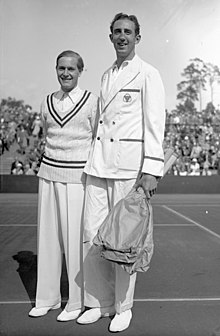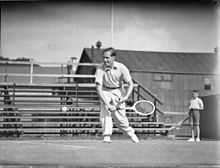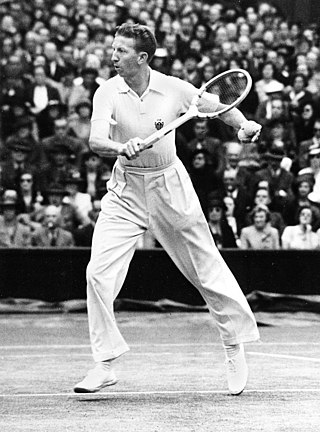
John Donald Budge was an American tennis player. He is most famous as the first tennis player — male or female, and still the only American male — to win the Grand Slam, and to win all four Grand Slam events consecutively overall. Budge was the second man to complete the career Grand Slam after Fred Perry, and remains the youngest to achieve the feat. He won ten majors, of which six were Grand Slam events and four Pro Slams, the latter achieved on three different surfaces. Budge is considered to have one of the best backhands in the history of tennis, with most observers rating it better than that of later player Ken Rosewall.

Frederick John Perry was a British tennis and table tennis player and former world No. 1 from England who won 10 Majors including eight Grand Slam tournaments and two Pro Slams single titles, as well as six Major doubles titles. Perry won three consecutive Wimbledon Championships from 1934 to 1936 and was World Amateur number one tennis player during those three years. Prior to Andy Murray in 2013, Perry was the last British player to win the men's Wimbledon championship, in 1936, and the last British player to win a men's singles Grand Slam title, until Andy Murray won the 2012 US Open.
1937 in sports describes the year's events in world sport.
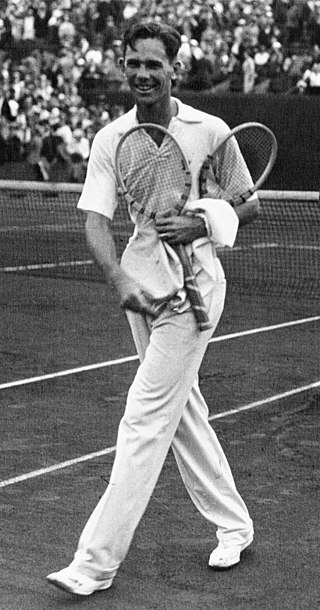
Henry Ellsworth Vines Jr. was an American tennis champion of the 1930s, the World No. 1 player or the co-No. 1 in 1932 as an amateur, and in 1934, 1935, 1936 and 1937 as a professional. He won three Grand Slam titles, the U.S. National Championships in 1931 and 1932 and the Wimbledon Championships in 1932. Vines also was able to win Pro Slam titles on three different surfaces. He later became a professional golfer and reached the semifinals of the PGA Championship in 1951.

John Herbert Crawford, was an Australian tennis player during the 1930s. He was the World No. 1 amateur for 1933, during which year he won the Australian Open, the French Open, and Wimbledon, and was runner-up at the U.S. Open in five sets, thus missing the Grand Slam by one set that year. He also won the Australian Open in 1931, 1932, and 1935. He was inducted into the International Tennis Hall of Fame in 1979.

Bryan Morel "Bitsy" Grant Jr. was an American amateur tennis champion. At 5 feet 4 inches (163 cm) and 120 pounds (54 kg), Grant was the smallest American man to win a championship on the international tennis circuit. A right-handed retriever, he was able to beat heavy-hitting greats such as Don Budge and Ellsworth Vines even when playing on grass. His nickname was "Itsy Bitsy the Giant Killer".

Heinrich Ernst Otto "Henner" Henkel was a German tennis player during the 1930s. His biggest success was his singles title at the 1937 French Championships.
The 1937 Wimbledon Championships took place on the outdoor grass courts at the All England Lawn Tennis and Croquet Club in Wimbledon, London, United Kingdom. The tournament was held from Monday 21 June until Saturday 3 July 1937. It was the 57th staging of the Wimbledon Championships, and the third Grand Slam tennis event of 1937. Don Budge and Dorothy Round won the singles title.
In the 1936 Wimbledon Championships men's singles competition, Fred Perry successfully defended his title, defeating Gottfried von Cramm in the final, 6–1, 6–1, 6–0 to win the gentlemen's singles title. Perry's victory was the last Wimbledon singles title won by a British male until Andy Murray won in 2013.
Don Budge defeated Gottfried von Cramm in the final, 6–3, 6–4, 6–2 to win the gentlemen's singles tennis title at the 1937 Wimbledon Championships. Fred Perry was the defending champion, but was ineligible to compete after turning professional at the end of the 1936 season.
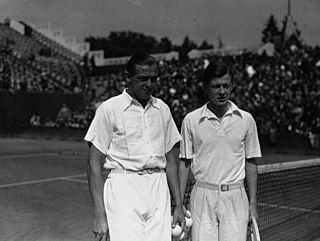
Gustav Jaenecke or Jänecke was a German ice hockey player who competed in the 1928 Winter Olympics, in the 1932 Winter Olympics, and in the 1936 Winter Olympics, and tennis player who played in three International Lawn Tennis Challenge ties for Germany.
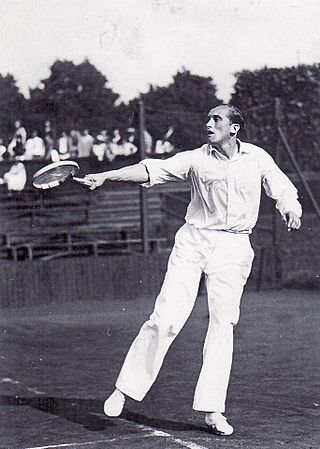
Roderich Ferdinand Ottomar Menzel was a Czech-German amateur tennis player and, after his active career, a writer.

Georg Felix Ritter von Metaxa was an Austrian tennis player active in the 1930s.
Norman Gordon Farquharson was a male tennis player from South Africa.
Manasse Herbst was a German-speaking silent movie actor, child-actor, theater actor and singer from Jewish descent. He participated in 416 sold-out performances of the operetta White Horse Inn between 1930 and 1932 in Berlin. During the first half of the 1930s, Herbst had a relationship with the German Baron Gottfried von Cramm, one of the more popular tennis players of the time. Because of this, von Cramm was sentenced in a Nazi propaganda trial that was recognized all over the world. Due to his Jewish background and the Nazi prohibition to perform his job, Herbst fled from Germany in 1936. Later, he became a U.S. citizen.
Don Budge and Gene Mako defeated the defending champions Pat Hughes and Raymond Tuckey in the final, 6–0, 6–4, 6–8, 6–1 to win the gentlemen doubles tennis title at the 1937 Wimbledon Championship.
Max Ellmer was a Swiss tennis player in the years before and after World War 2. Ellmer had a powerful backhand and good footwork. He played Davis Cup for Switzerland from 1933 to 1938. He won the Swiss Championships four times. He played at the French Championships and Wimbledon in a Grand Slam singles career that spanned the years 1930 to 1949. At the French Championships in 1934, Ellmer beat the 13th seed Wilmer Hines and won a set from eventual winner Gottfried von Cramm in losing in the fourth round. At Wimbledon in 1938, Ellmer beat 6th seed Dragutin Mitić in five sets before losing in straight sets to Bunny Austin in the quarter-finals. Ellmer beat former champion Jack Crawford in round one of the Wimbledon men's singles in 1947 before losing in the second round.

George McVeagh, also known as Trevor McVeagh and T. G. McVeagh, was an Irish sportsman who was capped in four sports for his country as a cricket, hockey, tennis, and squash player. He is considered the greatest all-round sportsman of his day in Ireland.
The 1937 Pacific Southwest Championships was a combined men's and women's amateur tennis tournament played on outdoor hard courts at the Los Angeles Tennis Club in Los Angeles, California in the United States. It was the 12th edition of the tournament and took place from September 19 through September 26, 1937. Don Budge and Alice Marble won the singles titles.
Franz-Wilhelm Matejka was an Austrian tennis player.
